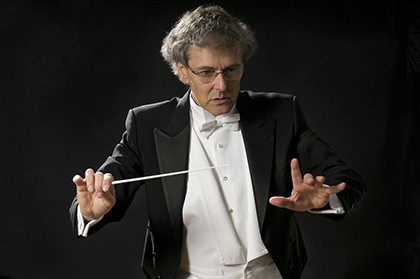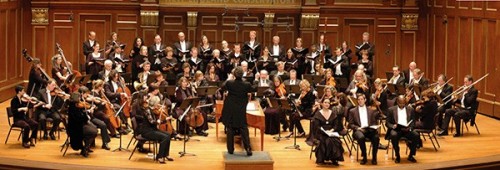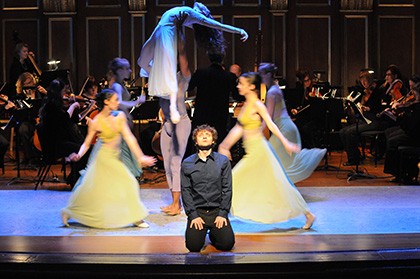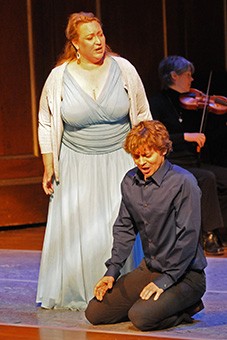Boston Baroque Presents Gluck's Orfeo ed Euridice
Lean Production Brings Out Opera's Beauties
By: David Bonetti - May 08, 2012
Orfeo ed Euridice
by Christoph Willibald Gluck
Libretto by Raniero Calzabigi
Conducted by Martin Pearlman
Directed by David Gately
Choreographed by Gianni Di Marco
Cast: Owen Willetts (Orfeo), Mary Wilson (Euridice), Courtney Huffman (Amor)
Dancers: Li-Ann Lim, Olga Marchenko, Kseniya Melyukhina, Kate Penner, Henoch Spinola (Orfeo), Ruth Whitney (Euridice)
Boston Baroque
Jordan Hall, New England Conservatory of Music
March 4 and 5, 2012
Is Gluck’s classic “reform” opera the most perfect work in the operatic repertory? Is the music Gluck (1714-1787) composed for it the most sublime? In the hands of Boston Baroque’s Martin Pearlman, his crack early music orchestra, a perfect cast of singers and dancers and an inspired semi-staging, you might have no problem answering, “yes,” “yes” and again “yes” a thousand times to any unasked question in the same line. I am sure I was not the only member of the audience who walked out on a cushion of air.
In a funny way, Gluck’s “Orfeo” is a repudiation of everything Boston Baroque stands for. The “reform” the work represented was based on stripping from music drama everything superfluous - complicated plots and subplots, rigid musical formulas and vocal ornaments that allowed virtuoso singers to show off their skills but ill-served the narrative, which are of course the essence of the baroque opera that has been Boston Baroque’s mission to produce for the past 30 years.
The evening’s artistic success demonstrated that there is no one better to strip a scaffold of extravagant growths than someone who understands it well. Pearlman conducted a brisk and lithe performance that brought out both the passion of the work’s relentless drama while allowing for virtuosic singing that melted the heart.
The story of Orpheus is not at the heart of the collection of Greek myths that form a cornerstone of Western culture. But because of its human details it is one of the most popular. The story of a man so in love that he goes to Hades to bring back his dead wife only to see her whisked away from him when he violates the only condition, that he not look at her until they are both back on earth. The myth seems to speak to something human in all of us – although I doubt that any of us have ever been a remotely similar situation.
The myth has been set to music and the subject of painting and sculpture since the Renaissance rediscovery of classical culture. When Florentine humanists sought to recreate Greek drama, which was originally sung, Orpheus was the first subject set to music. The first surviving opera of substance is Claudio Monteverdi’s chaste and dignified 1607 setting of the story. Some 150 years later Gluck composed an even more chaste and dignified work. Last November, the Boston Early Music Festival produced a pastiche that included the unfinished version Marc-Antoine Charpentier composed in 1686.
(By the way, none of those works set Orpheus’ own death to music. In the myth, after Euridice is returned to Hades after Orpheus looks at her, he is later torn to death by Maenads, angry, according to one version, that he has switched his allegiance from Dionysus to Apollo. In another, that, after the death of his beloved, he has shunned women for the love of beautiful boys. Maybe a contemporary composer could create a work based on the latter version of the myth. Calling John Corigliano!)
Gluck composed two versions of the work, and in contemporary practice elements from both are usually combined. The first version, the true “reform” work, was set to an Italian text and presented in Vienna in 1762. The second version, in French and expanded to include more dancing and a larger orchestra, was presented in Paris in 1774.
Pearlman has bravely produced the original version, jettisoning some lovely music, but, boy, does it pay off. The work is brief, with no breaks - arias, dances, choruses and orchestral passages moving seamlessly from one to another. There isn’t an ounce of fat in the entire work. It clocks in at 90 minutes, and the only error Pearlman made was to include an intermission. It would have been better if the work had moved swiftly to its conclusion in one unbroken movement. If audiences can sit for more than two hours through Wagner’s “Das Rheingold,” they should be able to sit for 90 riveting minutes through Gluck’s “Orfeo ed Euridice.” (By the way, Wagner respected Gluck – his through-composition without breaks offered Wagner a precedent for his own radical vision of music drama.)
David Gately’s semi-staging was as dramatically powerful as many fully staged productions. The orchestra occupied the back of the deep Jordan Hall stage, allowing it to shine in the vibrant overture, and a shallow but adequate space at the front of the stage was reserved for the singers and dancers. (The chorus moved from that space to risers at the back of the stage as needed.)
The uncredited costumes seemed to be the singers’ street clothes – a danger in Boston where local musicians tend to lack all sense of chic, even if they’re restricted to black. The dancers wore costumes – filmy robes for the women and tight body hugging outfits for the sole male dancer. The formula might not work for “Aida” or “Turandot,” but for Boston Baroque’s repertory it is perfectly adequate, throwing the power of persuasiveness to the performers.
British countertenor Owen Willetts might have worn a pair of trousers and a shirt that didn’t match in their tones of black, but as Orfeo he knocked you out from his first entrance. With the high, piercing lament of “Euridice!” when he first comes upon his dead wife, he caused shivers to run up my spine. His is a distinctive countertenor voice with the rich bottom tones of a contralto, which reminded me of Kathleen Ferrier, a renowned mid-century Orfeo, and a countertenor’s pure, high, almost unearthly sounds. He moved effortlessly from register to register and used his voice with great expressivity. From the single word, “riponde” (respond), after Euridice is returned to Hades, he was able to produce a range of sounds that painted all the colors of his grief. A young man with a thin frame and a mop of hair, he looked like a choirboy, but he sang robustly like an adult. It was passionately articulate singing, and he appears to be at the start of a brilliant career. His version of “Che faro senza Euridice,” (“What will I do without Euridice? Where will I go without my love?”), the opera’s most famous aria, was one for the record books, the best singing I heard in Boston all year. I hope Boston Baroque is planning to record this exquisite production.
“Orfeo” is basically a one-man opera, but in the small role of Euridice, soprano Mary Wilson was a moving counterpart to Willetts. As he leads her out of Hades, the two sing, in a rare duet, at wonderful cross-purposes. She muses that it might be better to go back to the peaceful pastures of the Underworld – the ancients’ view of Hades is more complex than ours – than live with a man who refuses her embraces. The role of Amor is very brief, and soprano Courtney Huffman made the most of it.
The chorus was as precise as the orchestra. In the famous scene when the guardians of Hades repeatedly reject Orpheus’s plea to enter and save his wife with a serious of spine chilling “nos,” the chorus outdid itself with its passion and precision.
Even though Boston Baroque excised the familiar expanded ballets written for the French version, the original dance music is in almost equal balance with the sung drama. Gianni Di Marco’s choreography was as chaste and passionate as the work required. His dancers practiced both traditional ballet toe dancing and an expressive, gesture-based movement that probably derives from Isadora Duncan. In any case, it was fluid and contributed beautiful moving images to the music. The corps of four female dancers moved expressively as both spirits of the dead and as the furies. The two soloists, Henoch Spinola as Orpheus and Ruth Whitney as Euridice, were a beautiful pair, bringing to mind images from the many paintings through the ages made of the two thwarted lovers. (I kept thinking of George Frederick Watts’s gorgeous paintings.)
Pearlman’s radical vision for “Orfeo ed Euridice” is a welcome tonic for a company steeped in baroque traditions. However, lovers of that complex and highly ornamented expression need not fret. The company has announced that its opera production next season will be Handel’s “Partenope,” with Boston’s favorite baroque singer Amanda Forsythe taking the lead role. Mark your calendars – October 19 and 20. But if you missed Pearlman’s “Orfeo ed Euridice,” kick yourself for having missed, with all respects to deKoven, a super out-of-this-world evening.







